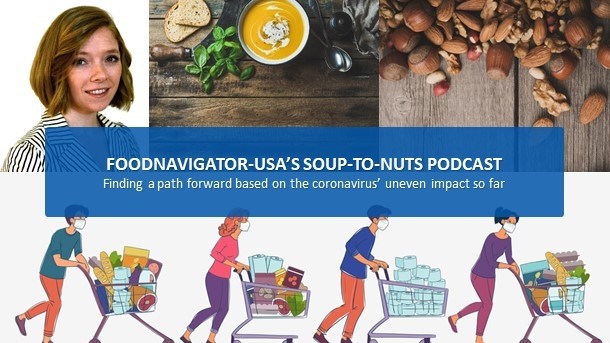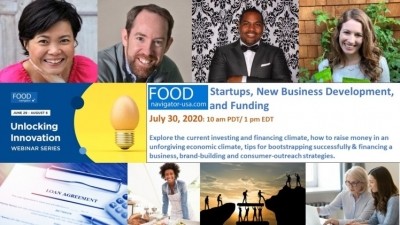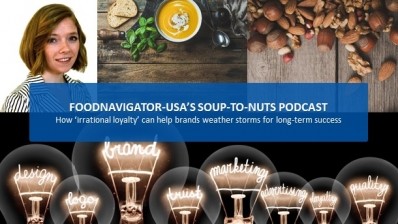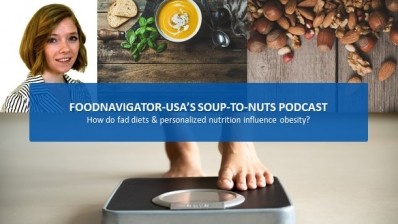Soup-To-Nuts Podcast: Navigating coronavirus’ uneven impact to chart a path forward for groceries

According to Jeff Grogg, the managing director at the food & beverage innovation and commercialization group JPG Resources, whether a company has fared well or not so far during the pandemic depends on where it sits in the competitive landscape, what it offers, its existing relationships with buyers, suppliers and co-manufacturers, and how brand leaders reacted to the coronavirus immediately before and during the initial outbreak.
In this episode of FoodNavigator-USA’s Soup-To-Nuts podcast, Grogg breaks down each of these components and how they relate to companies’ chances of survival during the pandemic, including insights on what is and isn’t selling currently, how to either meet increased demand or handle a drop in sales and how to work with stressed-out buyers and other partners across industry to make the most of the current situation. He also shares insights on how investors are evaluating the current and longer-term market potential for food and beverage brands, and advice for how to prepare for and weather an economic downturn that likely will last longer than the pandemic.
[Editor’s Note: Never miss another episode of FoodNavigator-USA’s Soup-To-Nuts podcast – subscribe on iTunes.]
A “disparate impact”
As with everything else that COVID-19 has touched, the virus’ impact on the food and beverage industry has been uneven and unpredictable, making it difficult to characterize the state of the current market because as Grogg notes, the traditional market forces no longer seem to be in play.
“A lot of brands … even small brands, are seeing extraordinary sales at this time. Others are getting pummeled or put off the shelf or their plans for expansion this year are delayed indefinitely,” said Grogg. He added, as in a recession, “it is always uneven, but I think this is more remarkably uneven, where some brands are down by half and other brands are up by three times. So, you know, I think I tis just that sort of the normal market forces aren’t in play and things change so rapidly, and so it is hard to speak about the market [as one entity] because the impact is so disparate.”
He explained that traditionally fast-moving categories, like bars, portable snacks and smaller pack sizes “aren’t move as well,” and neither are candy and chocolate.
At the same time, some smaller brands in fast moving categories that might have been slower to ramp up pre-COVID-19 are being picked up much more quickly because they are the only thing on the shelf, he added.
Inventory is key to weathering the pandemic
For those brands fortunate enough to be in a high-demand category, or to generate trial based solely on the virtue of being on store shelves, their ability to take advantage of those upsides has hinged in large part on their ability to attain and maintain inventories.
Grogg advises brands to build up an inventory of two to four weeks, if possible, to ensure they can meet retailer and consumer demand and also protect against the risk that a co-manufacturer might need to temporarily close due to illness.
On that note, he also advises companies to build in redundancies. If their co-manufacturer needs to shut its doors due to illness and cleaning, companies should know who else they can turn to for a quick production run, if necessary.
To get on store shelves, “be a listener to the buyer”
As the pandemic wears on, consumers’ patience and risk-tolerance for grocery shopping in stores is wearing down – resulting in them angling more for established brands they know and trust rather than exploring the aisles for new products. But, as Grogg noted, they will buy what is available, which means if emerging brands have products on the shelf in high demand categories, chances are high they will end up in shoppers’ carts.
The trick is getting on the shelf at a time when many buyers are scrambling to keep stores stocked while simultaneously working from home. To break through, Grogg recommends approaching buyers with ears open and their needs – not yours – in mind.
“It is a time to be a good listener and not just go in with your deck and pound away at what you want and what you need and how your brand is so special. I think, it is really a time to go in and say, ‘We think our brand meets this consumer need and meets your need and how do we do this together,” Grogg said.
“Hopefully, brands have the EQ to be able to have those kinds of discussions with the buyers, like, ‘Hey, what does the market need? What should I be doing? How do we help make sure you are maximizing your opportunities as the retailer,” he added.
Investors navigate two distinct paths through COVID-19
Getting on new store shelves often requires additional money to pay slotting fees, cover promotions and, of course, manufacturer sufficient products. Even under the best of circumstances this can be a tall order for emerging brands with limited cashflow, but Grogg warns coming up with extra money now may not be possible.
He explains that many investors are hitting pause on new deals and asking existing partners to reign in their spending, even if it means sacrificing growth.
“Investors in times of trouble, again whether it is the stock market or investing in emerging brands, when there is a lack of clarity, money gets tight and everybody clings to what they have,” Grogg said. But, he added, that also means they are willing to help what they have succeed, meaning reinvestment and follow-on funding is an option for companies with good investors.
Unfortunately, the lack of funding means not all food and beverage brands will survive the pandemic. Grogg warns those most at risk are the ones just starting out.
“Where you are going to find really high levels of attrition are brands that are … just started or maybe less than a couple of million bucks and who are in that mode of being quite a ways from profitability. They are funded by angels, they are not somebody who can necessarily go back and get significant operating funds,” Grogg said.
“Once you get up to $5m plus, if they are performing well, I think their investors will probably stand behind them,” he added.
While this financial forecast is grim, Grogg says there is the potential of a buy-out and consolidation by investors. He acknowledges this may not be what founders want in an ideal world, but he encourages them to consider it as a viable option – after all an exit is an exit.
Bracing for an economic downturn
While it is hard for many brands to think beyond the next week or two, Grogg says they should start planning for “reentry” once lockdowns begin to lift because that is likely when the full brunt of the virus’ negative economic impact will become apparent. To this he advises them to look back on consumer behavior during the Great Recession and consider what worked and didn’t work for companies in 2008 and 2009.
“If you look back again 12 years or so we saw short term dip in organic and premium, but then they actually rebounded pretty well, and people looked to food as an affordable luxury,” Grogg explained.
What this means for manufacturers is that premium and value brands will likely do well, but brands in the number three slot that are slightly more expensive than value products but not viewed as a special treat could see sales decline.
Another lesson from the recession to implement now is to focus on fundamentals and delivering to the retailer and the consumer by embracing comfort, health, indulgence or another need state.
“Really stand for something,” Grogg said.
That said, before a company can navigate a potential recession, it needs to survive the current pandemic, which is why Grogg advises founders and executives to continue to be on the defensive and ready for anything in the next four weeks. As he mentioned, this includes having extra inventory, following the news and being ready to move quickly and focusing on “nuts and bolts” rather than promotions.



















